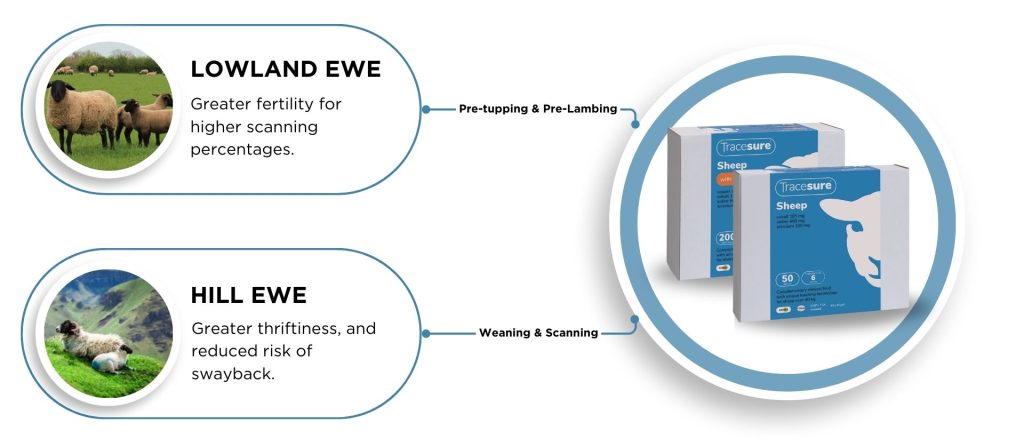Fertility at tupping is the single biggest influencer on any sheep enterprises’ bottom line. Ewes that tup well will go on to scan well, lamb well, and sell well.
The importance of tupping has been exacerbated by ongoing market trends:
- Record lamb prices
- Indications that replacements are going to cost an arm and a leg
- Unpredictable cereal and feed prices.
So, optimising ewe condition off grazing and forage is going to be paramount to a successful year in the business of sheep farming.
How to master ewe condition
Having ewes in better condition going into tupping will increase ovulation rate and embryo survivability. As the pregnancy progresses, producers will witness better foetal development and less risk of metabolic disease.
Before tupping, lowland flocks should be targeted at 3.5 body condition score (BCS), and hill breeds targeted at 3.0.
Start working on hitting targets early, even as soon as spring, by checking ewe condition while handling for other jobs. Earlier weaning decisions and getting underconditioned ewes ‘flushed’ on good quality forage in plenty of time can be a powerful tool. This is often underutilised in favour of weaning by the calendar.
Proactively monitor ewe condition through the lactation and keep an eye on grass stocks to support the BCS of the ewe and performance of this year’s lamb crop.
How to master trace element nutrition
Almost all grazing land is short in one or more of the essential trace elements – cobalt, copper, iodine, and selenium.
Sheep are also often naturally exposed to trace element antagonists – such as iron, manganese, sulphur, aluminium, and molybdenum – that can compromise trace element uptake.
More specifically, sheep on brassicas – such as rape, kale, or turnips – are exposed to goitrogen substances known to inhibit the availability of iodine. Trace elements are all collectively critical to digestion (forage utilisation), immunity, and reproduction.
| Cobalt | Cobalt is converted by rumen bacteria into Vitamin B12 critical for energy cycles, metabolism, lamb growth and pregnancy. |
| Copper* | Copper is required during gestation by the ewe for development of the lamb’s central nervous system. Inadequate supply mid-pregnancy may result in swayback. |
| Iodine | Iodine deficiency in ewes during the breeding season can manifest as poor condition, reduced fertility, and decreased foetal viability. |
| Selenium | Selenium is critical for normal cell function, fertility, and effective immune responses to viral, bacterial and parasite encounters. |
*A forage or soil analysis, or indeed studying any historic records of the farmland, can indicate if there is a copper deficiency and or antagonists. Always consult your vet or SQP to establish whether there is a need to supplement copper, as excess copper can result in copper toxicity which can be fatal.
Supplying less than enough trace elements can impact on condition, fertility, lamb development and thrift. More than enough trace elements will either by-pass what the ewes can physically absorb or cause toxicity and cost you money.
Test before supplementing
To determine your flock’s current trace element status, a mineral audit consisting of a forage or soil analysis and a dietary analysis (including all forages and supplementary feed) can be undertaken. Blood analysis with your vet can also be carried out on a suitable sample size of animals. Another great tool is post-mortems of fallen stock, if fresh liver tissue can be analysed for trace element status presenting some useful information for your vet to form a plan with you.
Results of these tests should be discussed with a suitable advisor (vet, nutritionist and/or SQP) to form a suitable trace element feeding and supplementation regime.
What to do if tests show a trace element deficiency
If a deficiency is detected, first look to the type of supplementation best suited to the system. It doesn’t matter if you are a lowland or hill farm – if you are reliant on grazing – bolusing is the easiest and most precise and effective form of supplementation you can count on.
Compared to other modes of supplementation, when proactively bolusing with ANIMAX Tracesure® Sheep, you can count on every animal with a bolus having what they need every day for up to 6 months. It only takes a matter of seconds and can be coincided with other management activity.
Whether you’re seeking higher scanning percentages or greater lamb thriftiness, proactively giving a bolus in the weeks before tupping will reduce the risk of any performance-limiting trace element deficiencies. Leaving one less variable to worry about. It’s the complex, made simple.

Trace element sheep bolus comparison
| Trace element levels (mg, total) | Bolus number required | Suitable liveweight | Duration of cover | Mode of action | ||||
| Product | Cobalt | Copper | Iodine | Selenium | ||||
| ANIMAX Tracesure® Sheep | 185 | 4000
(optional) |
660 | 100 | 1 | 20kg+ / 40kg+ * | 180 days | Diffusion |
| Agrimin 24:7 Smartrace ® Sheep | 144 | 3366
(optional) |
756 | 72 | 2 | 40kg+ | 180 days | Eroding |
| Bimeda® Sheep Coseicure | 160 | 4200 | 320 | 48 | 1 | 30kg+ | 243 days | Dissolving |
| Bimeda® Sheep Zincoisel | 166 | 0 | 330 | 49 | 1 | 30kg+ | 180 days | Dissolving |
| Mayo All Guard Ewe 4/5 in 1 | 350 | 4000
(optional) |
750 | 70 | 1 | 2kg+ DMI | 180 days | Oxidising |
| Mayo Cobalt Master | 1000 | 0 | 0 | 100 | 1 | 16+weeks | 365 days | Oxidising |
| Endurabol Sheep | 198 | 3240 | 756 | 108 | 1 | 40kg+ | 180 days | Eroding |
*ANIMAX Tracesure® Sheep without copper – sheep must weigh over 20kg. ANIMAX Tracesure® Sheep with copper – sheep must weigh over 40kg.
5 reasons to choose ANIMAX Tracesure® Sheep:
- Features patented diffusion technology®, enabling the safe inclusion of high levels of selenium and iodine with superior ruminal retention.
- Includes a rumen-available form of cobalt for immediate and long term coverage.
- Available with or without a copper bolus and includes copper oxide made in-house to meet critical parameters.
- Compact and small in size, making it easy to administer for any breed and size of sheep.
- Uniquely approved for use on organic systems by the Soil Association (UK) and IOA (Ireland), and is qualifiable for the Organic Farming Scheme in Ireland*.
*Only ANIMAX Tracesure® without copper is approved for use on organic systems, but can be used in conjunction with the ANIMAX medicinal copper oxide bolus, under derogation.
Qualified for the Sheep Improvement Scheme
ANIMAX Tracesure® Sheep boluses qualify for the Sheep Improvement Scheme in Ireland under the category ‘mineral supplementation of ewes post mating’. Lasting up to 6 months, the bolus can be given in the weeks before tupping as it lasts into pregnancy.
Farmers looking to improve the welfare of their flock are paid €12 per breeding ewe up until 31 December 2024 provided all actions are completed.
Remember to look after the boys
It is common for tups to get less care and attention compared to ewes. However, given the fact they play an equal part in fertility, this is a not a step to skip. Rams can lose up to 15% body weight during tupping, so start condition checking rams 6-12 weeks before tupping!
Here’s your 6-point checklist:
1. BCS
BCS should be between 3.5 and 4.0. Feed allowances may be required to increase energy, allow for testicular growth and semen production. If you’ve been feeding your rams prior to tupping, continue daily feeding. Although it is an extra job, it can pay dividends for multiple reasons. It gives you a daily opportunity to check keel/harness, monitor lameness issue, and also maintain that condition they need to maximise their ability to tup as many ewes as possible
2. Testicles
Testicles should be flexible but also as firm as a tensed bicep, and free of any lumps and bumps and woolliness. The scrotum should measure to the following circumference (measured together at widest point):
| Lowland breeds | Hill breeds | |
| Mature Ram | 36 – 38 cm | 34 – 36 cm |
| Shearlings | 32 – 34 cm | 30 – 32 cm |
| Lamb Ram | 30 cm | 28 cm |
Semen analysis through your vet will check for semen motility, density, and any signs of abnormality.
3. Health condition
Rams should show no signs of lameness and be treated for any scald, foot rot or Contagious ovine digital dermatitis (CODD) if appropriate. Teeth should be checked for abnormalities and (molar) abscesses. Listen for any ‘snoring’ sounds and seek veterinary treatment if this is heard. Check for cracks and infection at the base of horns, abscesses around throat and neck, sunburnt skin, wool loss and irritation, and the brisket for any painful sores.
4. Biosecurity
Replacement tups should be on-farm for 4 or more weeks prior to breeding to allow time for biosecurity treatments, and to settle-in so they aren’t exposed to stress at the crucial hour. Follow the SCOPS advice for quarantine treatments to avoid importing, scab, Resistant worms, fluke and other issues onto farm.
5. Condition
Check for cracks and infection at the base of horns, abscesses around throat and neck, sunburnt skin, wool loss and irritation, and the brisket for any painful sores.
6. Trace elements
Trace elements are vital for sperm quantity and quality, and with production beginning as soon as 8 weeks in advance of its release, bolusing against any deficiencies 10-12 weeks pre-tupping is vital for giving those trace elements enough time to do make an impact on their fertility. Bolus rams at the same time as gimmer and ewe lambs.
Check out the SVS Ram Pre-Breeding Examination Certificate

